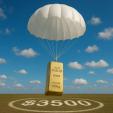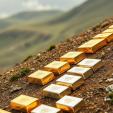USD weakness could reignite gold rally as semis drive silver demand and platinum jewelry ramps up
NEW YORK (July 14) While gold’s price performance has lagged of late, a weakening U.S. dollar may be enough to jumpstart the next leg of the rally, while silver is benefiting from record-breaking semiconductor demand and platinum sees surging jewelry production, according to precious metals analysts at Heraeus.
In their latest precious metals update, the analysts wrote that the recent weaker forecasts for the U.S. dollar could help restart the gold price rally.
“Globally, analysts have significantly pared back forecasts for the US dollar at year-end 2025,” they noted. “Consensus Q4’25 forecasts have fallen from 107.25 in mid-January to 96.8 as of last Friday, versus the current DXY Index level of 97.80. The median forecast sees the dollar falling 1% by year-end, and by a further 4% in 2026.”

“The post-‘Liberation Day’ economic environment is far less supportive of dollar strength as tariffs add to the risk of stagflation in the US, and dollar strength built up during the Fed hiking cycle will unwind further,” the analysts said. “In the Fed meeting’s minutes last week, the majority of Fed officials were still in favour of two further interest rate cuts this year, despite a deferment of actual cuts to the second half of the year.”
Heraeus said that even with gold prices stalled below the April high of $3,500 per ounce, the yellow metal still has support at $3,240. “If the dollar weakens as predicted and investment/central bank demand for the metal remains high, the price should continue to rise following this consolidation,” they said. “However, should the gold price drop below support, any further upside could be delayed until much later this year.”
After hitting a high of $ 3,375.08 overnight, spot gold slid lower during North American trading on Monday, last trading at $3,349.75 per ounce for a loss of 0.18% on the session.

Turning to silver, Heraeus analysts said semiconductor sales are on pace to set another record this year and should contribute significantly to total silver demand.
“Electrical and electronics demand for silver is one of the major industrial applications for silver, making up nearly 40% of global silver demand (1,164 moz) in 2024,” they wrote. “Semiconductors (semis) sales are a good indicator for the electronics market as they are ubiquitous in most modern devices. Semis sales reached a record high in 2024 and are expected to show double-digit growth this year, according to the Semiconductor Industry Association (SIA). Year-to-date, semis sales are well ahead of last year, with May 2025 sales of $59 billion nearly 20% higher year-on-year. This follows an increase in global revenue of 19.1% year-on-year in 2024.”
“The rapidly expanding semis market, driven by AI and cloud infrastructure advances, indicates the electronics market is currently strong, which should see silver demand in electronics rise this year,” they added. “This may be enough to offset the expected decline in silver demand in solar PV applications this year and should have a positive price impact. The growth in the semis market is forecast to continue in 2026, albeit at a lower rate (source: World Semiconductor Trade Statistics), and should continue to underpin non-solar electrical and electronics demand for silver over the longer term. However, sales revenue for semiconductors exhibits highly cyclical behaviour, equal to approximately eight quarters peak-to-trough. Growth at the current rate has not lasted for much more than a year since 2005, suggesting a downturn may be approaching and adding downside risk to 2026 growth forecasts.”
The analysts pointed out that Friday’s weekly close of $38.18 per ounce in the spot market was the highest in nearly 14 years, and took silver’s year-to-date gains to 30%.
Silver prices actually broke above $39 per ounce in overnight trading, but like gold, the gray metal was driven lower once U.S. traders joined the party. At the time of writing, spot silver last traded at $38.354 per ounce and is down 0.13% on the daily chart.

And on the platinum front, Heraeus noted that platinum jewelry fabrication is surging, but retail demand is lagging behind.
“Chinese jewellery accounted for approximately 390 koz, or 5% of global demand last year, having fallen from nearly 2 moz over the preceding decade when it represented nearly 25% of global demand,” the analysts said. “Demand is conservatively forecast to rise to just over 400 koz in China this year as indicators there are turning more positive on platinum jewellery. Platinum Guild International (PGI) reports that in Q1’25 platinum jewellery fabrication increased by 50% year-on-year in China, driven by a structural shift away from gold amid a more favourable gold-platinum price spread and evolving consumer preferences. However, retail sales rose by only 16% among PGI’s key partners, and are expected to continue to lag the surge in fabrication.”
They noted that on balance, the Chinese luxury jewelry market is underperforming this year. “Gold jewellery demand fell to a five-year low of 133 tonnes in Q1’25 (source: World Gold Council), and several large domestic jewellery retailers have reported a drop in sales in recent quarters,” they wrote. “Overall low growth or contraction in jewellery buying could translate to a longer lag between fabrication demand and retail sales for platinum jewellery. Also, as the platinum price has rallied over the last month, gold has remained stable, narrowing the price advantage that platinum jewellery had over yellow and white gold coming into 2025 and removing some of the incentive for consumers.”
After trading above $1,460 per ounce on Friday and maintaining lofty levels overnight, platinum was driven down along with the rest of the metals complex on Monday, only more so, though it has held support above $1,400.

Spot platinum last traded at $1,403.16 per ounce for a loss of 3.85% on the session.
KitcoNews










